Abstract
The present study was undertaken to examine the intestinal phase of cholecystokinin (CCK) secretion and gall bladder contraction in patients with severe pancreatic insufficiency. Plasma CCK concentrations, measured by radioimmunoassay, and gall bladder contraction by cholescintigraphy were studied in response to intraduodenal fat with and without addition of pancreatic enzymes. Fasting plasma CCK concentrations were in the same range in six patients with pancreatic insufficiency with (2.6 (0.2) pmol/l) and without (2.6 (0.3) pmol/l) addition of pancreatic enzymes and in six healthy subjects (2.0 (0.4) pmol/l). The integrated plasma CCK secretion in response to intraduodenal fat was significantly (p less than 0.005) reduced in the patients without addition of enzymes (46 (13) pmol/1.90 min) compared with healthy subjects (199 (22) pmol/1.90 min), but increased significantly (p less than 0.01) by the addition of pancreatic enzymes (174 (25) pmol/1.90 min) to values not significantly different from healthy subjects. Similarly, gall bladder emptying in response to intraduodenal fat was significantly (p less than 0.01) reduced in patients with pancreatic insufficiency without addition of enzymes (at 90 min: 35 (11)%) compared with healthy subjects (at 90 min: 66 (7)%) but significantly (p less than 0.01) increased by addition of pancreatic enzymes (at 90 min: 70 (8)%) to values not significantly different from healthy subjects. These results indicate that patients with severe pancreatic insufficiency have impaired gall bladder emptying after intraduodenal fat, which can be normalised by the addition of pancreatic enzymes. This impaired gall bladder emptying appears to be the result of a reduced plasma CCK response. Thus, intra-intestinal pancreatic enzymes play an important role in the intestinal phase of CCK secretion and gall bladder emptying.
Full text
PDF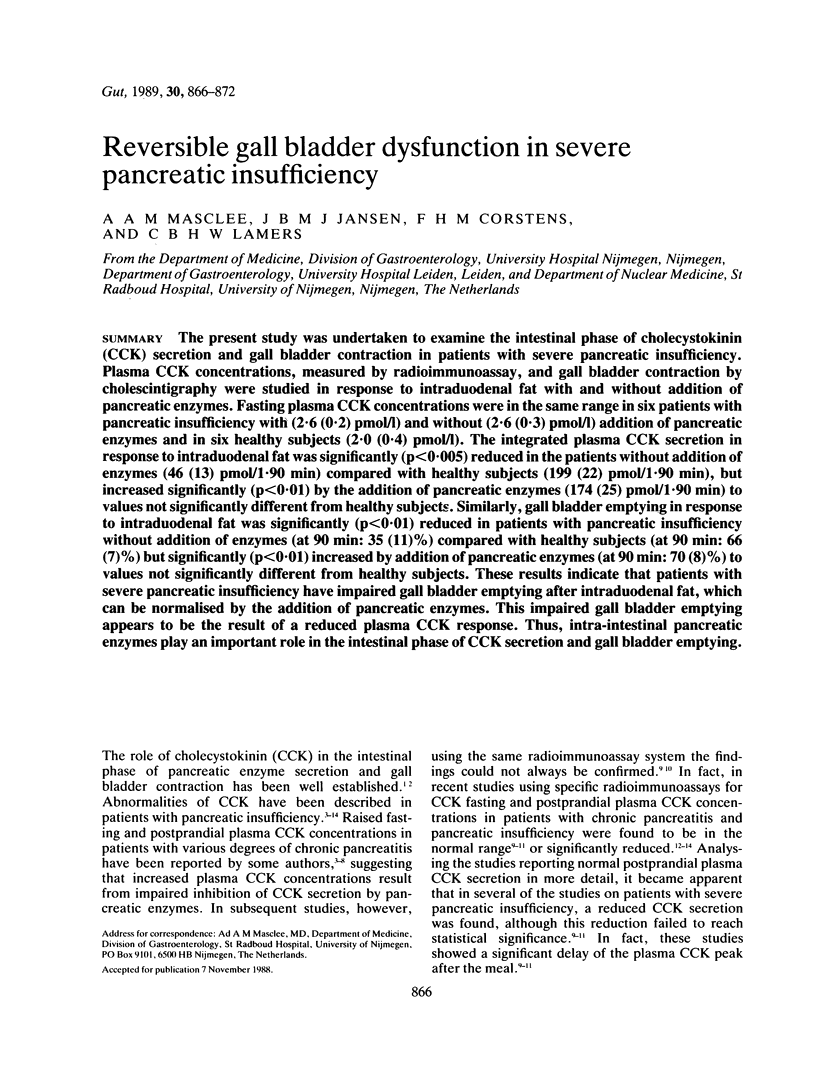
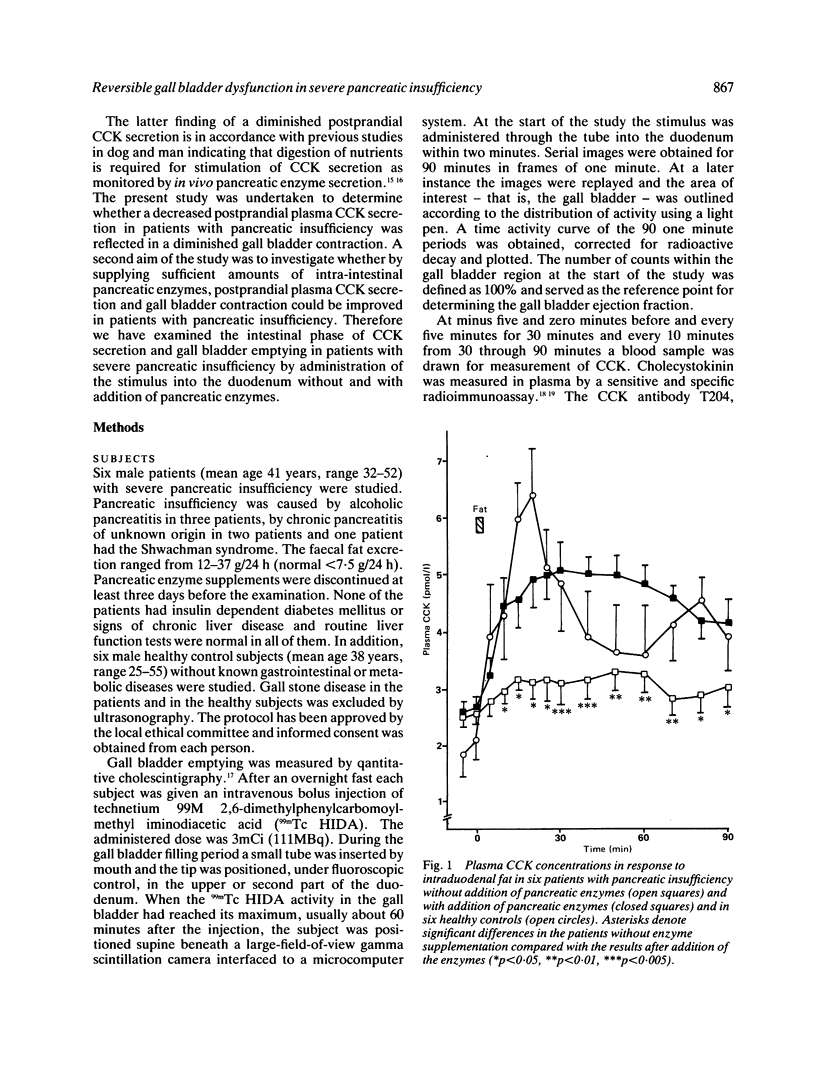
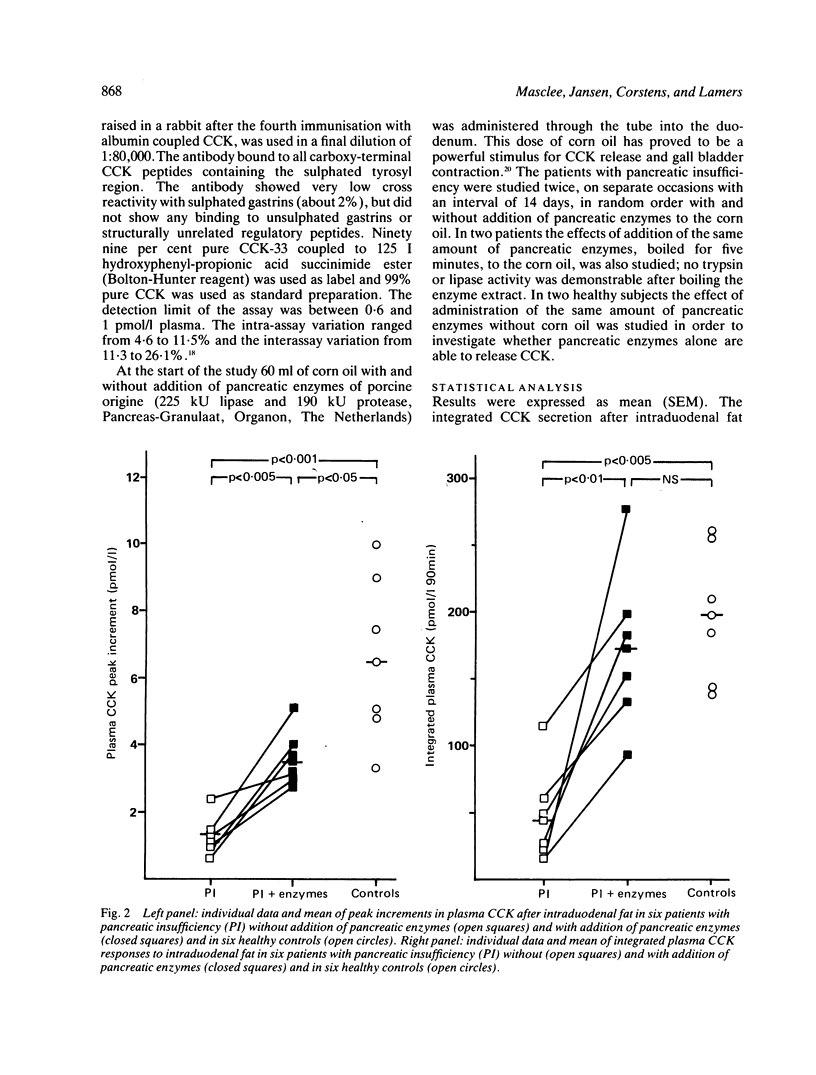

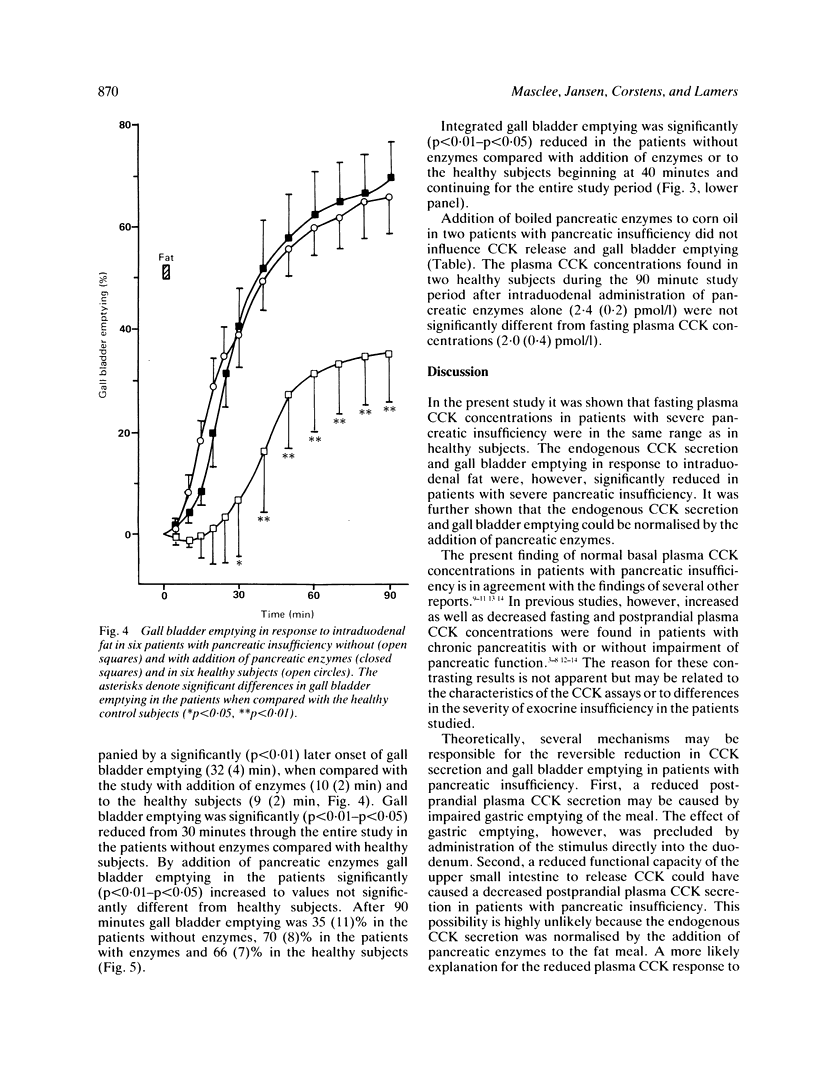
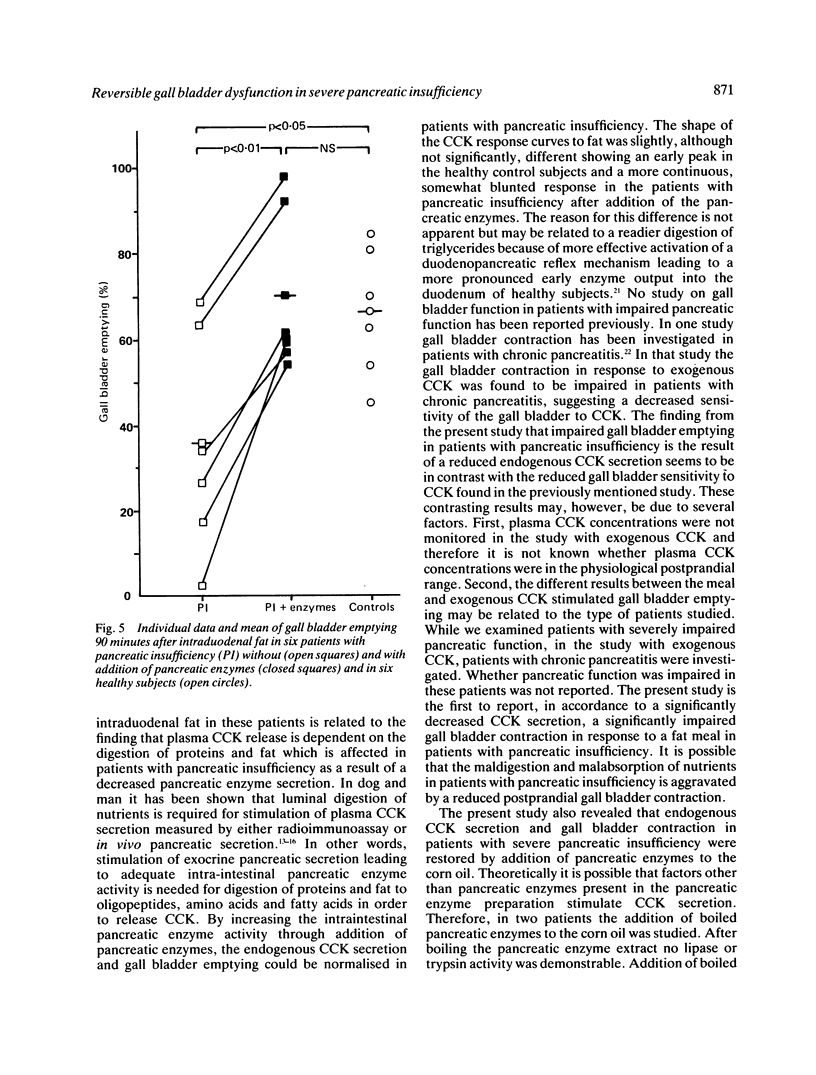
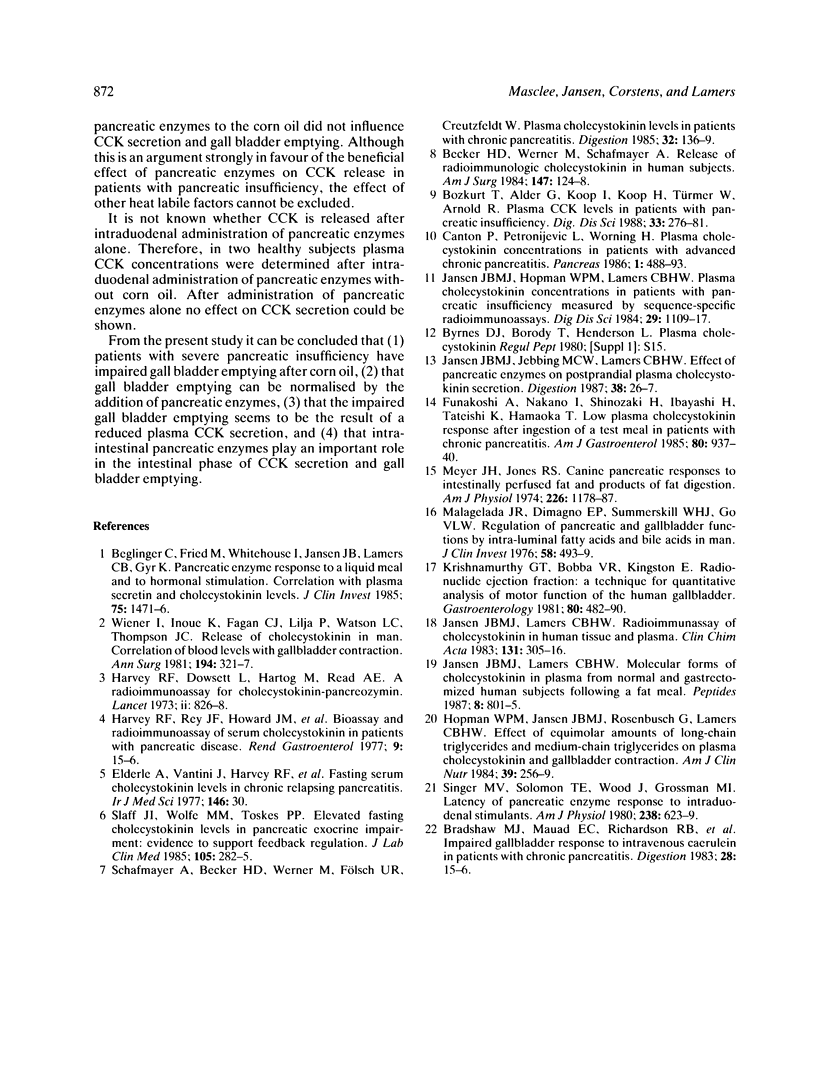
Selected References
These references are in PubMed. This may not be the complete list of references from this article.
- Becker H. D., Werner M., Schafmayer A. Release of radioimmunologic cholecystokinin in human subjects. Am J Surg. 1984 Jan;147(1):124–129. doi: 10.1016/0002-9610(84)90045-x. [DOI] [PubMed] [Google Scholar]
- Beglinger C., Fried M., Whitehouse I., Jansen J. B., Lamers C. B., Gyr K. Pancreatic enzyme response to a liquid meal and to hormonal stimulation. Correlation with plasma secretin and cholecystokinin levels. J Clin Invest. 1985 May;75(5):1471–1476. doi: 10.1172/JCI111850. [DOI] [PMC free article] [PubMed] [Google Scholar]
- Bozkurt T., Adler G., Koop I., Koop H., Türmer W., Arnold R. Plasma CCK levels in patients with pancreatic insufficiency. Dig Dis Sci. 1988 Mar;33(3):276–281. doi: 10.1007/BF01535749. [DOI] [PubMed] [Google Scholar]
- Cantor P., Petronijevic L., Worning H. Plasma cholecystokinin concentrations in patients with advanced chronic pancreatitis. Pancreas. 1986;1(6):488–493. doi: 10.1097/00006676-198611000-00004. [DOI] [PubMed] [Google Scholar]
- Funakoshi A., Nakano I., Shinozaki H., Ibayashi H., Tateishi K., Hamaoka T. Low plasma cholecystokinin response after ingestion of a test meal in patients with chronic pancreatitis. Am J Gastroenterol. 1985 Dec;80(12):937–940. [PubMed] [Google Scholar]
- Harvey R. F., Dowsett L., Hartog M., Read A. E. A radioimmunoassay for cholecystokinin-pancreozymin. Lancet. 1973 Oct 13;2(7833):826–828. doi: 10.1016/s0140-6736(73)90863-5. [DOI] [PubMed] [Google Scholar]
- Jansen J. B., Hopman W. P., Lamers C. B. Plasma cholecystokinin concentrations in patients with pancreatic insufficiency measured by sequence-specific radioimmunoassays. Dig Dis Sci. 1984 Dec;29(12):1109–1117. doi: 10.1007/BF01317085. [DOI] [PubMed] [Google Scholar]
- Jansen J. B., Lamers C. B. Radioimmunoassay of cholecystokinin in human tissue and plasma. Clin Chim Acta. 1983 Jul 15;131(3):305–316. doi: 10.1016/0009-8981(83)90100-6. [DOI] [PubMed] [Google Scholar]
- Krishnamurthy G. T., Bobba V. R., Kingston E. Radionuclide ejection fraction: a technique for quantitative analysis of motor function of the human gallbladder. Gastroenterology. 1981 Mar;80(3):482–490. [PubMed] [Google Scholar]
- Malagelada J. R., DiMagno E. P., Summerskill W. H., Go V. L. Regulation of pancreatic and gallbladder functions by intraluminal fatty acids and bile acids in man. J Clin Invest. 1976 Aug;58(2):493–499. doi: 10.1172/JCI108493. [DOI] [PMC free article] [PubMed] [Google Scholar]
- Meyer J. H., Jones R. S. Canine pancreatic responses to intestinally perfused fat and products of fat digestion. Am J Physiol. 1974 May;226(5):1178–1187. doi: 10.1152/ajplegacy.1974.226.5.1178. [DOI] [PubMed] [Google Scholar]
- Schafmayer A., Becker H. D., Werner M., Fölsch U. R., Creutzfeldt W. Plasma cholecystokinin levels in patients with chronic pancreatitis. Digestion. 1985;32(2):136–139. doi: 10.1159/000199231. [DOI] [PubMed] [Google Scholar]
- Slaff J. I., Wolfe M. M., Toskes P. P. Elevated fasting cholecystokinin levels in pancreatic exocrine impairment: evidence to support feedback regulation. J Lab Clin Med. 1985 Mar;105(3):282–285. [PubMed] [Google Scholar]
- Wiener I., Inoue K., Fagan C. J., Lilja P., Watson L. C., Thompson J. C. Release of cholecystokinin in man: correlation of blood levels with gallbladder contraction. Ann Surg. 1981 Sep;194(3):321–327. doi: 10.1097/00000658-198109000-00010. [DOI] [PMC free article] [PubMed] [Google Scholar]


